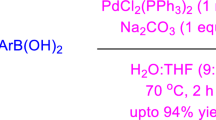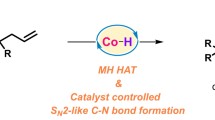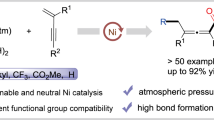Summary
The regioselectivity of the nitrile oxide cycloaddition with 3,3-methylene-1-(3,5-dichlorophenyl)-2,5-pyrrolidindione (1) is discussed. Arylnitrile oxides add regioselectively to the carboncarbon double bond of1, giving exclusively spiro-isoxazolines3a–k, whereas acetonitrile oxide gives both adducts3l and4l. AM1 calculations of the reactants and cycloadducts were performed, the regiochemistry of the cycloaddition seems to be controlled by steric effects. Reduction of3a with NaBH4 in the presence of magnesium perchlorate at −20 °C was regio-and stereoselective to yield the hydroxylactams9a and10a, whereas hydroxymethylisoxazoline14a was obtained in the absence of Mg(ClO4)2.
Zusammenfassung
Es wird die Regioselektivität der Cycloaddition von Nitriloxiden mit 3,3-Methylen-1-(3,5-Dichlorphenyl)-2,5-pyrrolidinon (1) diskutiert. Arylnitriloxide addieren regioselektiv an die Kohlenstoff-Kohlenstoff-Doppelbindung von1 unter ausschließlicher Bildung der Spiroisoxazoline3a–k, währenddessen Acetonitriloxid beide Addukte3l und4l ergibt. AM1-Rechnungen der Reaktanden und der Cycloaddukte sprechen dafür, daß der regiochemische Verlauf der Cycloaddition durch sterische Effekte bewirkt wird. Reduktion von3a mit NaBH4 in Gegenwart von Magnesiumperchlorat bei −20 °C ergab in einer regio- und stereoselektiven Reaktion die Hydroxylaktame9a und10a, in Abwesenheit von Mg(ClO4)2 wurde Hydroxymethylisoxazolin14a erhalten.
Similar content being viewed by others
References
Matocsy G., Nádasy M., Andriska V. (1988) Pesticide Chemistry. Budapest: Akadémiai Kiadó
Schmeling B. V. (1962) Phytopathology52: 819
Světlik J., Veverka M. (1990) Liebigs Ann. Chem.: 111
Ueda M., Hamura M., Kitagawa J., Sugai S. (1991) J. Chem. Soc. Perkin Trans.1: 2145
Borenstein M. R., Abou-Gharbia M. A., Doukas P. H. (1984) Heterocycles22: 2483
Longeon A., Guyot M., Vacelet J. (1990) Experentia46: 548
James D. M., Kunze H. B., Faulkner D. J. (1991) J. Nat. Prod.54: 1137
Kobayashi J., Tsuda M., Agemi K., Shigemori H., Ishibashi M., Sasaki T., Mikami Y. (1991) Tetrahedron47: 6617
Howe K., Shelton B. R. (1990) J. Org. Chem.55: 4603
Brandi A., Cordero F. M., De Sarlo F., Gandolfi R., Rastelli A., Bagatti M. (1992) Tetrahedron48: 3323
Oravec P., Fišera Ľ., Ertl P., Végh D. (1991) Monatsh. Chem.122: 821
Oravec P., Fišera Ľ., Goljer I., Ertl P. (1991) Monatsh. Chem.122: 977
Sustamann R., Huisgen R., Huber H. (1967) Chem. Ber.100: 1802
Caramella P., Grünanger P. (1984) Nitrile Oxides and Nitrile Imines. In: Padwa A. (ed.) 1,3-Dipolar Cycloaddition Chemistry, Vol. 1. New York; Wiley, p. 292
Koumbis A. E., Stephanidou-Stephanatou J., Alexandrou N. E. (1991) J. Heterocyclic Chem.28: 605
Coutouli-Argyropoulou E., Thessalonikeos E. (1992) J. Heterocyclic Chem.29: 251
Dewar M. J. S., Zoebisch E. G., Healy E. F., Stewart J. J. P. (1985) J. Am. Chem. Soc.107: 3902
Houk K. N., Sims J., Duke R. E., Strozier R. W., George J. K. (1973) J. Am. Chem. Soc.95: 7287
Mukaiyama T., Hoshino T. (1960) J. Am. Chem. Soc.82: 5339
Konopíková M., FiĽera š., Prónayová N. (1992) Coll. Czech. Chem. Commun.57: 1521
Světlík J., Liptaj T., Hanuš V. (1992) Liebigs Ann. Chem.: 591
Goto T., Konno M., Saito M., Sato R. (1989) Bull. Chem. Soc. Jpn.62: 1205
Speckamp W. N., Hiemstra H. (1985) Tetrahedron41: 4367
Hitchings G. J., Vernon J. M. (1990) J. Chem. Soc. Perkin Trans.1: 1757
Werner A., Buss H. (1894) Ber. Dtsch. Chem. Ges.27: 2193
Veverka M., Král'ovičová E. (1989) Coll. Czech. Chem. Commun.54: 2731
Fišera Ľ., Al-Timari U. A. R., Ertl P., Prónayová N. Monatsh. Chem., submitted
Author information
Authors and Affiliations
Additional information
Part XXX in the series 1,3-Dipolar Cycloaddition on Heterocycles. Part XXIX [27]
Rights and permissions
About this article
Cite this article
Fišera, Ľ., Konopíková, M., Ertl, P. et al. Regioselectivity in the 1,3-dipolar cycloaddition of nitrile oxides to N-(3,5-dichlorophenyl)itaconimide. Monatsh Chem 125, 301–312 (1994). https://doi.org/10.1007/BF00811316
Received:
Accepted:
Issue Date:
DOI: https://doi.org/10.1007/BF00811316




